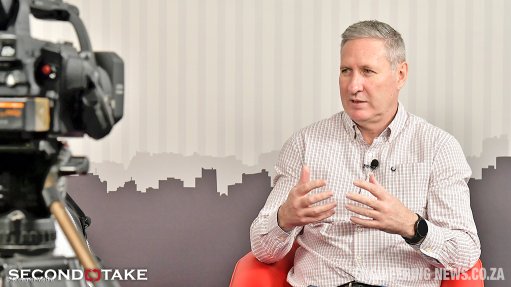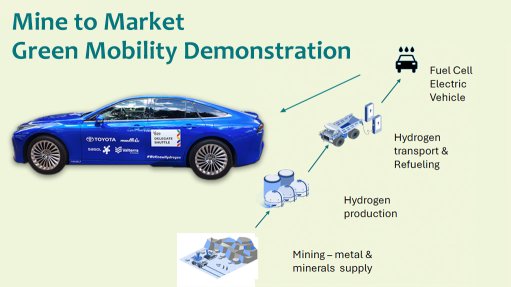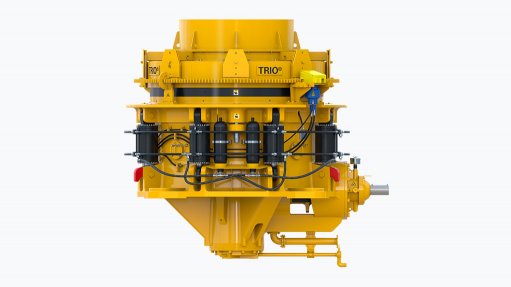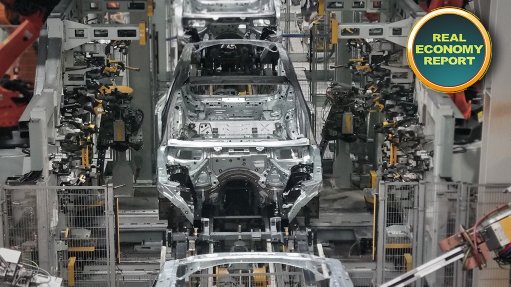Platinum jewellery, investment strong in China, platinum bar sales launched on TikTok

World Platinum Director of Research Edward Sterck interviewed by Mining Weekly's Martin Creamer. Video: Darlene Creamer.
A leading branded jewellery retailer in Beijing is including platinum investment bars in its offering amid platinum bar sales being launched on TikTok for the first time by a World Platinum Investment Council (WPIC) partner.
Chinese buying of platinum investment bars smaller than 500 g have grown 140% year-on-year to a record 31 000 oz, with overall first-quarter bar and coin demand up 17% to 70 000 oz.
Investment demand has been driven by a sharp rise in exchange-held platinum stocks as tariff-related uncertainty and a widening location premium encouraged higher platinum inflows into the US.
“We’re also seeing very strong jewellery demand, particularly in China,” WPIC research director Edward Sterck highlighted to Engineering News & Mining Weekly in a comprehensive interview that coincided with the publication of WPIC’s latest first-quarter Platinum Quarterly.
Overall first-quarter platinum jewellery demand increased 9% to 533 000 oz and platinum is the big beneficiary of the many jewellers in China wanting to have investment products on offer.
Overall first-quarter platinum investment demand rose 28% quarter-on-quarter to 461 000 oz and the WPIC-linked Shanghai Platinum Week in the second week of July is likely to elevate platinum demand still further.
Stores of value are being sought and platinum fits that bill, particularly at this time of an exceptionally high gold price.
Full-year bar and coin investment is forecast to strengthen by 30% to 252 000 oz, driven by 48% growth in China and a return to growth in the North American market at a forecast 18%. Growth in bars of or above 500 g in China is predicted to continue its upward trajectory to reach a 15%-higher 186 000 oz.
Despite capacity constraints and increasing competition in the first four months of this year, WPIC partners have achieved record-breaking sales, positively influenced by the sweeping resurgence of platinum jewellery demand in China.
Quarterly gains in green hydrogen hit the 159% mark and overall global first-quarter demand lifted 10% to 2 274 000 oz on the strong investment demand, driven principally by a sharp rise in exchange-held platinum stocks. Full year hydrogen demand is expected to rise by 35% to 59 000 oz.
At the same time, first-quarter mining supply fell 13% year-on-year to 1 086 000 oz, the lowest since the second quarter of 2020 and a first-quarter deficit of 816 000 oz emerging as the largest single quarterly deficit in six years.
“I think the deficit is embedded. It’s structural, and we’re likely to see a series of deficits come through in future years as well,” Sterck noted.
On top of the ongoing robust global demand for platinum group metals (PGMs), these amazing metals are becoming increasingly diverse, with the four core automotive, industrial, jewellery and investment demand segments combining to provide a beneficial degree of resilience, even as the US government’s new approach to tariff policy starts to take effect.
“Platinum’s diversity of end uses is to its benefit. A lot of those end uses are quite price inelastic, so, ultimately, you’ve got to get down to the product level for things really to change,” Sterck pointed out.
This beneficial diversity enabled strong first-quarter investment demand growth to counter-balance declines in automotive and industrial demand, which took place in the thick of platinum supply falling 10% to 1 458 000 oz and which could not be offset by a modest year-on-year recovery in recycling.
Automotive demand remained resilient despite market uncertainty and the strategic importance of PGMs to the US automotive industry has so far spared the metals from US tariffs and even the broader impact of trade restrictions is highly unlikely to materially reduce the deficit of 966 000 oz of platinum the WPIC is forecasting for 2025.
In the quarter, tariff-related exchange-held inflows of platinum into the US totalled 361 000 oz.
Engineering News & Mining Weekly: The platinum market is in structural deficit – do you expect this to change in light of the current geopolitical uncertainty?
Sterck: There’s a huge amount of uncertainty around at the moment, and that makes putting in place forecasts quite challenging. So, the first answer is, absolutely, there’s potential for changes to come through. That said, I think platinum’s diversity of end uses is to its benefit. A lot of those end uses are quite price inelastic, so ultimately, you’ve got to get down to the product level for things really to change. Now, part of the uncertainty that’s associated, in principle, with these tariffs that the US is trying to bring into place, is reflected in the forecasts. Our deficit of 966 000 oz, which has increased by 118 000 oz from our March update, includes a 50 000 oz reduction to automotive demand. That’s related to US tariffs. However, that’s more than offset by an increase in jewellery demand. We’re seeing very strong jewellery demand, particularly in China, and part of that’s related to the high gold price. It’s also related to an increase in investment demand. Again, that’s partially related to the high gold price, but also due to the kind of politico-economic uncertainty. People are looking for stores of value, and platinum fits the bill. So, yes, there is scope for things to change, but as things stand at the moment, based upon a snapshot today, we think that the risks are factored into that forecast, and the market deficit is also, I would add, a very substantial one of almost a million ounces in what is almost an eight-million-ounce-a-year market. It’s pretty difficult to envisage a scenario whereby this economic uncertainty would negatively impact demand to the point that that deficit would be eradicated. So, I think the deficit is embedded. It’s structural, and we’re likely to see a series of deficits come through in future years as well.
What effect have the US tariffs had on platinum demand and supply?
There have been quite a number of different effects. If we start with supply, supply is broadly unimpacted by the US tariffs. There might be some kind of impacts in secondary supply, given that these tariffs are likely to result in an increase in vehicle prices in the US. That means people scrap fewer vehicles and they continue to run older vehicles for longer. That could reduce recycling supply, for example. We’re still waiting to see how the dust settles on that one before updating numbers there. But in terms of demand, that’s really where the impacts will be felt. Higher vehicle prices in the US could reduce demand for new vehicles. We estimate that every 1% increase in vehicle prices in the US reduces demand by half a percent, so there is a moving scale here in terms of the potential impact. Our forecasts already have 50 000 oz demand loss baked into them. To see a bigger change to that would probably require a fairly seismic shift in the tariffs as proposed. The tariffs for vehicles and for automotive parts have moved around a bit, and it feels like they’ve kind of settled on where they’re going to play out now, so I think those numbers are fairly embedded. Another area where we could see a negative impact is jewellery, if that would be subject to tariffs. But on the other hand, platinum sponge, platinum ingot, isn’t subject to tariffs, and can be imported easily into the US. However, some investment products are tariffed. Minted product that is not currency is subject to tariffs, so that does impact some of the investment bars that are produced in Europe and sold in the US. So, there are some things that could negatively impact the outlook there, but we have seen quite a lot of pre-buying ahead of tariffs in order to try and get ahead of that, and there are work-arounds that people are trying to put in place.
What’s been happening to supply?
Well, mine supply is its lowest in five years on a quarterly basis, at the beginning of 2025, but if you look past the first quarter of 2020, which was heavily impacted by the Anglo American Platinum ACP outage and the beginnings of COVID, it’s the lowest quarter in mine supply in our time series going back to 2013, so quite significant. The year as a whole is also expected to be particularly weak. I think it is the weakest in our time series, and again, if you look beyond 2020, and other people’s time series, back until the 1990s, so mine supply is under strain. The first quarter was particularly heavily impacted by the rains that South Africa experienced and the associated flooding, but it was also negatively impacted by some smelter outages, both planned and unplanned, by the restructuring of some operations in North America, and by smelter refurbishment in Zimbabwe as well. So, there were quite a few specific quarterly challenges that obviously we would expect supply to recover from. I think the overall trend in supply is for a structural erosion of output.
Why are strong platinum jewellery gains anticipated in China?
We’re seeing big shifts in China. We’re taking a fairly cautious view on this, and I’m not sure that the potential is fully baked into the forecast, as yet. If we were having this conversation even six months ago, I’d probably have said something like flat’s the new outlook for jewellery. But we’re seeing things change really quickly, and it’s largely due to that high gold price. Fabricators and retailers are seeing a significant decline in gold jewellery purchases because consumers are being priced out of the market. But also, I think, the psychology is gold is so high at the moment, and given that jewellery in China is a quasi- investment-type purchase, consumers are somewhat worried that the downside risk to gold is greater than the upside potential, and so they’re not buying gold. The fabricators and retailers are pivoting some of their product offering away from gold and into other metals, and platinum is a big beneficiary of that, and that’s helpful for the fabricators and retailers as well, because the price of gold having gone so meteoric has massively increased their working capital requirements, so switching into other metals helps release that working capital, and platinum is a higher margin product, and we’re seeing a lot of gold stores in Shenzhen and Xu Bay, which are the main jewellery centres in China, being turned over 100% to platinum jewellery, so a lot of encouraging green shoots there and hopefully that continues.
Production Decline
With weakness across all major producing regions, except Russia, South Africa accounted for the bulk of the decline, experiencing unusually intense rainfall during the quarter, leading to a 10% year-on-year drop in refined output to 715 000 oz.
The fall in total mining supply was partially offset by an increase in global recycling supply of 2% to 372 000 oz. As a result, total supply fell 10% year-on-year to 1 458 000 oz.
While some recovery is likely throughout the remainder of 2025, full year total mining supply is expected to reach a 6%-lower 5 426 000 oz, which is 11% below the five-year pre-COVID average.
Global recycling is forecast to show a modest recovery in 2025, growing 3% year-on-year to 1 573 000 oz as the supply of spent autocatalysts improves slightly.
Overall, total supply is expected to decline by 4% in 2025 to 6 999 000 oz.
Above-ground stocks are forecast to decline by 31% to 2 160 000 oz, resulting in only three months of demand cover.
Jewellery Recovery
For full year 2025, jewellery demand is expected to continue the recovery seen in 2024, increasing by 5% year-on-year to 2 114 000 oz, as platinum continues to benefit from its price discount relative to gold.
Strong gains are anticipated in China, up 15% year-on-year to 474 000 oz, while European demand is forecast to grow 7% to reach a record high.
North America will also see 8% growth, while demand in India is due to soften, falling 10% year-on-year to 240 000 oz owing to reduced exports amid US tariff uncertainty.
Article Enquiry
Email Article
Save Article
Feedback
To advertise email advertising@creamermedia.co.za or click here
Comments
Announcements
What's On
Subscribe to improve your user experience...
Option 1 (equivalent of R125 a month):
Receive a weekly copy of Creamer Media's Engineering News & Mining Weekly magazine
(print copy for those in South Africa and e-magazine for those outside of South Africa)
Receive daily email newsletters
Access to full search results
Access archive of magazine back copies
Access to Projects in Progress
Access to ONE Research Report of your choice in PDF format
Option 2 (equivalent of R375 a month):
All benefits from Option 1
PLUS
Access to Creamer Media's Research Channel Africa for ALL Research Reports, in PDF format, on various industrial and mining sectors
including Electricity; Water; Energy Transition; Hydrogen; Roads, Rail and Ports; Coal; Gold; Platinum; Battery Metals; etc.
Already a subscriber?
Forgotten your password?
Receive weekly copy of Creamer Media's Engineering News & Mining Weekly magazine (print copy for those in South Africa and e-magazine for those outside of South Africa)
➕
Recieve daily email newsletters
➕
Access to full search results
➕
Access archive of magazine back copies
➕
Access to Projects in Progress
➕
Access to ONE Research Report of your choice in PDF format
RESEARCH CHANNEL AFRICA
R4500 (equivalent of R375 a month)
SUBSCRIBEAll benefits from Option 1
➕
Access to Creamer Media's Research Channel Africa for ALL Research Reports on various industrial and mining sectors, in PDF format, including on:
Electricity
➕
Water
➕
Energy Transition
➕
Hydrogen
➕
Roads, Rail and Ports
➕
Coal
➕
Gold
➕
Platinum
➕
Battery Metals
➕
etc.
Receive all benefits from Option 1 or Option 2 delivered to numerous people at your company
➕
Multiple User names and Passwords for simultaneous log-ins
➕
Intranet integration access to all in your organisation

















